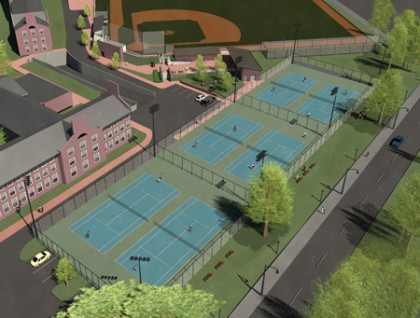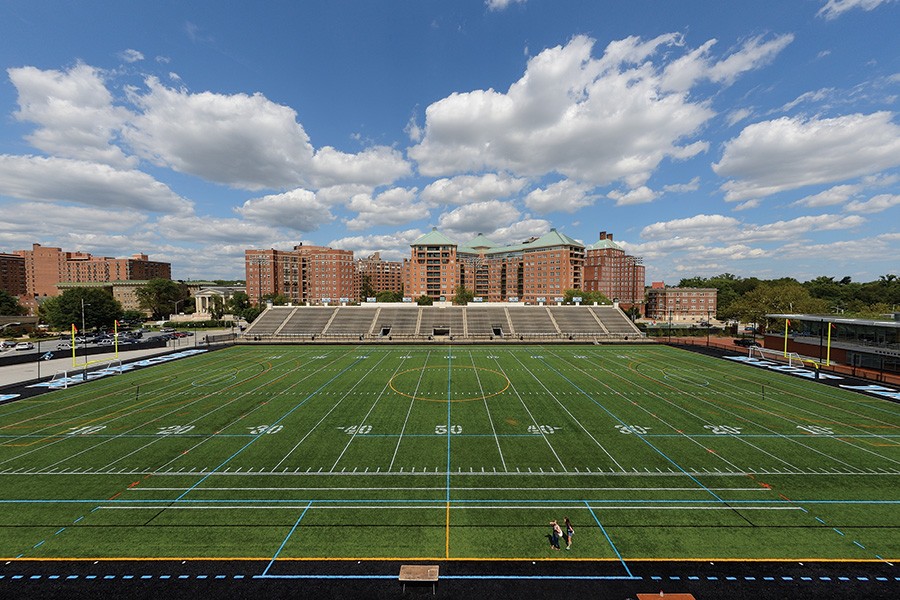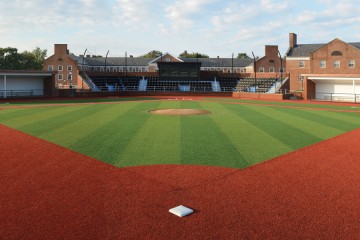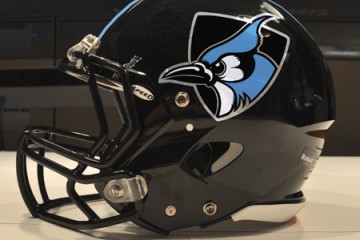Bill Harrington pauses to pick up a tiny white wrapper that has blown onto the otherwise unblemished synthetic turf on Babb Field at Stromberg Stadium, the gleaming new home of Blue Jays baseball. Moments later, Harrington, director of Recreation and Facilities for the Athletics Department, kneels down to spread out some infill kicked up by a recent rainstorm. He admires his handiwork and then continues with an informal tour of the facility, just weeks from its late-summer completion.

Image caption: Just like players in the U.S. Open, the Blue Jays will be slamming balls on a DecoTurf surface. The courts will also have a new lighting system and spectator seating.
Forgive Harrington his moments of field vanity. In many respects, the university has just traded in a mile-laden, rusted used car for a fully loaded BMW. Harrington is only too happy to polish the tires.
This fall, Johns Hopkins starts a new chapter in its storied athletic history with the opening of new, significantly upgraded facilities for the varsity baseball and tennis programs. The university also will debut a resurfaced Homewood Field and a new Blue Jay logo that will unify JHU athletics and tie in with the university's branding initiative.
Tom Calder, the university's director of Athletics since 1995, says that the renovated facilities, which are wrapped by University Parkway and North Charles Street, will create a new face for Blue Jays sports and revitalize the northern doorstep of the Homewood campus.
"Years ago, one alum came up to me and said it would be great to have that corner become a welcome mat for the university and to really brand it Johns Hopkins—I agreed," Calder says. "That was the theme we carried all through these projects. We envisioned someone driving on University Parkway or North Charles Street and glancing in at our students playing or practicing on magnificent new facilities. That was the dream, and now it's a reality."
The $5 million baseball facility is named for longtime baseball head coach Bob Babb, who recently notched his 1,000th win, and lead donor and university trustee Bill Stromberg, arguably JHU's greatest football star and also a baseball player during his time at Homewood, from 1978 to 1982.
The stadium features an all-weather turf playing surface, home and visitor dugouts, and, behind home plate, a 260-seat, ADA-accessible grandstand with a modern press box. The infield and outfield are one uniform, baseball-specific synthetic surface made to appear to look like both grass and dirt. The field can rapidly drain water and be playable just 30 minutes after a heavy rain. The resilient surface will mean fewer rained-out games, Harrington says, and it allows for other varsity teams and recreational clubs to use the field when not in use by baseball.
Other features include new home and away bullpen areas, batting cages, and backstop and outfield fencing. A 20-foot net extends above the right-field fence to help catch home-run balls before they reach University Parkway.
Harrington says that the field will play both fast and small, likely resulting in increased offense. "I expect there will be more home runs hit. But home runs are fun, and it's fair for both teams," he says. "It's going to be a dynamic park."
In addition to improving the in-person experience, the facility will provide opportunities not previously available, including live video streaming of games.
Plans are for the field to be outfitted with lights and a new scoreboard in time for the start of baseball season next spring. The scoreboard was made possible by a donation from Jim and Heather Murren, who is a university trustee. Jim played baseball at Trinity, and the couple thought it would be a great idea to support the new baseball facility at Johns Hopkins.
The stadium replaces a field that had been in use since the 1930s, with only minimal renovations over the years. Fans sat on aluminum bleachers behind home plate and down the first- and third-base lines. Harrington says that the old baseball diamond—which he likened to a subpar high school field—was arguably in the bottom 10 percent of Division III baseball. "We were doing our best to improve the field, but it was obvious that it needed to be completely overhauled," he says. "With this new stadium, we hope to attract more fans. It's going to be a great place to watch an afternoon baseball game, and I'm sure it will invigorate the players. When you have a bigger crowd, you're going to get into it more."
Babb, the fifth-winningest active coach in Division III baseball, says that the field did not leave a good impression on visitors or recruits. Now, the new stadium is the first thing he shows prospective students, and it's already paying dividends.
"We had a baseball camp in early July, and everyone was very impressed," Babb says. "Because of this new field, we are going to attract some kids who normally would not have come. Everything about [the stadium] is really special, and I know our players are dying to get on the field. This is where we should be, facilitywise. We had fallen behind everyone who we were recruiting against. Now we'll have one of the best stadiums in Division III, and I think it will have a huge impact on our program."
Next to the baseball stadium will sit the new facility for the men's and women's tennis teams. The existing six playing courts, which were cracked and overdue for repairs, will be completely resurfaced, and a new lighting system will be installed. The hard court will have the same DecoTurf surface used at the Billie Jean King National Tennis Center, home of the U.S. Tennis Association's U.S. Open. The facility will also include spectator seating.
Since arriving at Homewood in 2005, tennis coach Chuck Willenborg has built Johns Hopkins into one of the top programs in the nation. The men's team has won seven consecutive Centennial Conference titles and made eight straight trips to the NCAA Tournament under his guidance, and the women's team has also won seven consecutive conference titles, with trips to the NCAA Tournament in each of those years. Baseball and tennis will share a new plaza with restrooms and storage areas, and netting will be erected to protect the tennis courts from foul balls.
The new-look Homewood Field playing surface, consisting of 40 rolls and 40,000 pounds of fiber turf, was installed early in the summer. The field, which was last replaced in 2005, was stripped down to its stone base just after Memorial Day to make way for a new surface, which mirrors the look and feel of natural grass and is the same synthetic turf system used by the Baltimore Ravens at M&T Bank Stadium. It features a new black border with "Johns Hopkins" painted in blue at one end zone and "Blue Jays" on the opposite side.
The soccer sidelines and end lines are in yellow, with all other line markings in blue and black. Harrington says that the university went for a bold, clean look in keeping with its new identity initiative. The black used in the nonplaying areas allows Athletics to use various logos and text on it throughout the year, such as the Big Ten logo come lacrosse season.
First to use the new surface will be football, which opens its season at home on Sept. 6.
Calder says that it's been a busy and exciting summer for University Athletics, and that he can't wait to show off the improvements. He'll get his chance soon. The grand opening of Babb Field at Stromberg Stadium will be held on Sept. 20, and up to 500 people are expected to attend the ceremony.
Posted in Athletics, University News
Tagged women's lacrosse, men's lacrosse, baseball, football, tennis, soccer










